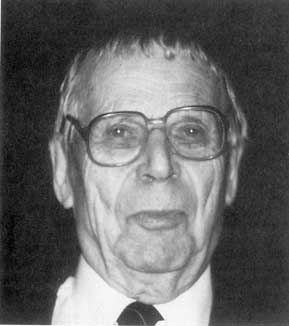
Lars Valerian Ahlfors
 المؤلف:
Biography in Encyclopaedia Britannica
المؤلف:
Biography in Encyclopaedia Britannica
 المصدر:
Biography in Encyclopaedia Britannica
المصدر:
Biography in Encyclopaedia Britannica
 الجزء والصفحة:
...
الجزء والصفحة:
...
 3-11-2017
3-11-2017
 673
673
Born: 18 April 1907 in Helsingfors, Finland, Russian Empire (now Helsinki, Finland)
Died: October 1996 in Pittsfield, Massachusetts, USA

Lars Ahlfors' father was professor of mechanical engineering at the Polytechnic Institute in Helsingfors. Tragically his mother died in childbirth when he was born. Ahlfors describes his early years in [2]:-
As a child I was fascinated by mathematics without understanding what it was about, but I was by no means a child prodigy. As a matter of fact I had no access to mathematical literature except in the highest grades. Having seen many prodigies spoilt by ambitious parents, I can only be thankful to my father for his restraint. the high school curriculum did not include any calculus, but I finally managed to learn some on my own, thanks to clandestine visits to my father's engineering library.
Ahlfors entered Helsingfors University in 1924, and there he was taught by Lindelöf and Nevanlinna. He graduated from Helsingfors in 1928. Nevanlinna replaced Weyl in Zurich for the session 1928/29 while Weyl was on leave, and Ahlfors went to Zurich with him. In Zurich Nevanlinna lectured on Denjoy's conjecture on the number of asymptotic values of an entire function. Ahlfors modestly writes in [2]:-
I had the incredible luck of hitting upon a new approach, based on conformal mappings, which, with very considerable help from Nevanlinna and Pólya, led to a proof of the full conjecture.
Ahlfors went to Paris with Nevanlinna for three months before returning to Finland. There he was appointed lecturer in mathematics in Turku. He presented his doctoral thesis in 1930, then in the following two years he made a number of visits to Paris and other European centres.
In 1935, Caratheodory, whom Ahlfors had met in Munich during his travels, recommended him for a post at Harvard in the United States. Ahlfors agreed to a three year trial period. In 1936 he was one of the first two recipients of a Fields Medal at the International Congress in Oslo.
In 1938 Ahlfors was offered a chair in mathematics at the University of Helsinki and, being rather homesick, he accepted this rather than remain permanently at Harvard. However a difficult time was approaching with World War II about to begin. The war led to severe problems in Finland and the universities were closed. Ahlfors was unfit for military service so, as he states in [2]:-
Paradoxically I was myself able to do a lot of work during the war, although without the benefit of accessible libraries.
Ahlfors' family was evacuated to Sweden during the war and so, when he was offered a chair in Zurich in 1944 it seemed a good chance to be reunited with his family. He met up with his family in Sweden, where Beurling gave them a great deal of help and friendship, but the war made the trip to Switzerland close to impossible. A flight from Stockholm to Prestwick in Scotland was arranged and, in March 1945, they made the trip. From Glasgow they travelled by train to London, then they made the difficult journey across the Channel, across France via Paris to Switzerland. He writes [2]:-
I cannot honestly say that I was happy in Zurich. The post-war era was not a good time for a stranger to take root in Switzerland. ... My wife and I did not feel welcome outside the circle of our immediate colleagues.
An offer from Harvard in 1946 was therefore gladly accepted and, on this occasion, he remained there, retiring in 1977.
His books are of lasting importance. Among them are Complex analysis (1953), Riemann surfaces (with L Sario) (1960). Lectures on quasi-conformal mappings (1966) and Conformal invariants (1973). In addition to the topics covered by these texts, Ahlfors did work of major importance on Kleinian groups.
Allow me [EFR] a personal note on Ahlfors' Complex analysis. This was the text recommended to me by Copson who taught me complex analysis and it is indeed a tribute to Ahlfors that Copson, who had himself written a superb book on complex analysis, should recommend Ahlfors' book rather than his own. I found Ahlfors' Complex analysis beautifully written, an example of the very highest quality in mathematical texts, combining clarity with an excitement for the topic.
Ahlfors received many honours for his outstanding contributions to mathematics. The award of the first Fields medal, mentioned above, must rank as the most important but another great honour was the award of the Wolf Prize in Mathematics in 1981.
- Biography in Encyclopaedia Britannica.
http://www.britannica.com/eb/article-9094742/Lars-Valerian-Ahlfors
Books:
- O Lehto, On the life and work of Lars Ahlfors, The Mathematical Intelligencer 20 (4) (1999), 4-8.
- R M Shortt (ed.), Lars Valerian Ahlfors : Collected papers (Boston-Basel, 1982).
 الاكثر قراءة في 1905to1909
الاكثر قراءة في 1905to1909
 اخر الاخبار
اخر الاخبار
اخبار العتبة العباسية المقدسة


